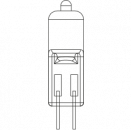All about light bulb technologies and its applications
About Auer Signal
Auer Signal is a global leading manufacturer of signaling technology, operational in 70+ countries. The company produces stack lights, visual-, audible-, visual-audible and explosion proof signaling devices.
Discover Signaling Devices NOW!
The discovery and further development of the light bulb technology dates back to the 1830s. It started much more with an experiment, performed by British inventors. They experimented with electrical current in order to produce light – and they succeeded. Even though the light bulbs back then did work, they consumed way too much energy and had a very short lifespan. Their short lifespan would have required the inventors to manufacture lots of them in order to replace the old and used ones. But back then, it was a very expensive process to manufacture these light bulbs.
It was not until forty years later, that the American inventor and businessman Thomas Edison started working on improving the earlier light bulb prototypes in order to expand their lifespan and also improve the resistance of the lamp. He started to experiment with a carbonized bamboo filament which lasted up to 1,200 hours and thereby succeeded in developing a more practical light bulb. But it was not only Edison, who experimented with other components. Before he discovered the benefit of using carbonized bamboo filaments, British physicist Joseph Wilson Swan filed for patent for a complete incandescent light bulb with a carbon filament.
Within the last 190 years, the light bulb technology has been improved massively. The lifespan of light bulbs not only got longer, the energy consumption also became much lower and they are more environmental-friendly now. Thanks to all the developments that have been made, we can choose between a variety of light bulb technologies, for all kinds of needs.
Light bulb comparison: Which light bulb technologies are available?
In electronics there is a variety of illuminants used for optical signaling. The various illuminants differ in terms of power consumption, the required light output or the desired beam angle. Here you can find more light bulb information on the different light bulb technologies that are used today:
LED (Light Emitting Diode) light bulb*
LED lamps are among the most modern of all light sources, they are the newest light bulb technology. Over the course of time, they have established themselves as state-of-the-art technology. Signal lights from Auer Signal rely mainly on the latest LED technology with particularly high luminosity and long service life.
Xenon light bulb*
Xenon light can be found in selected flashing lights from Auer Signal. The xenon flash tube generates a high signal effect through intensive light pulses.
Incandescent light bulbs*
The conventional bulb, or incandescent lighting, is only very rarely used for optical signaling nowadays. Due to its weak light output and low resistance, this bulb is unsuitable for most applications compared to other lighting technologies such as LED technology.
Halogen lamp*
Halogen lamps work similar to incandescent lighting, but due to the filling with halogens they have a higher burning temperature and therefore a better efficiency. Signaling devices with halogen lamps were used in the continuous, flashing and rotating mirror beacons of the M series from Auer Signal until 2020.
HID (high-intensity discharge) lamp
High-intensity discharge lamps are a special type of electrical gas-discharge arc lamps, which create light by sending an electrical discharge by means of an electric arc between two electrodes, which are placed inside of a translucent fused quartz or a fused alumina arc. The initial strike of the arc is enabled by a noble gas, which is filled into the tube. This tube also often contains suitable metal or metal salts. After the initial strike, the arc heats up, evaporates the metallic admixture and creates a high intensity of visible light. Unfortunately, the lumen output of high-intensity discharge lamps is likely to deteriorate by up to 70% over 10,000 burning hours.
Compact Fluorescent lamps (CFL)
The compact fluorescent lamp is, as the name already says, a fluorescent lamp which is designed to replace an incandescent light bulb. This lamp uses a compact electronic ballast in the lamp’s base and a curved or folded tube, which fits into the space of an incandescent bulb. In comparison to general incandescent lamps, which give the same amount of visible light, the compact fluorescent lamp only uses up to one-third of the electric power. It also has a longer lifespan.
Linear Fluorescent light bulb
The linear fluorescent light bulb is a type of low-pressure gas-discharge lamp, which uses fluorescence in order to produce visible light. It converts electrical energy into visible light. Compared to incandescent bulbs with a comparable light output, linear fluorescent light bulbs have a luminous efficacy of 500-100 lumes per watt. This lamp is known for its high efficiency and its long lifespan.
Edison light bulb
This form of light bulb is becoming more and more popular these days, as the trend is going towards buying vintage products. The Edison light bulb is also known as an antique light bulb, because of its components and its look. The Edison Electric Light Company produced these light bulbs, which had long windings of their internal filaments. The reproductions that are on the market today, also have these windings as well as the warm-yellow glow of the light, for which these light bulbs are known for.
*These lamps are built into the visual signaling devices from Auer Signal
With all these various types of light bulbs, it can become a challenge, to choose the right one. Let’s have a more detailed look at these technologies to see all of their functions and benefits.
What is a LED lamp?
The abbreviation LED stands for “light emitting diodes”. An LED lamp or LED light bulb is an electric light for the use in lighting units, that creates light using one or more light emitting diodes. LED lamps consist of special semiconductor material, commonly indium-gallium-nitride (InGaN), that convert electrical voltage into visible bright blue light. This enables LEDs to produce light through electroluminescence. In order to change the bright blue light to a white light, a phosphor coated casing can be used.
Compared to other light sources, LEDs are many times more environmentally friendly and considerably more efficient than most fluorescent lamps. LED lamps also have a longer lifespan than equivalent incandescent lamps. LEDs are commonly used in traffic lights, large video screens, indicator lights on devices and automobiles.
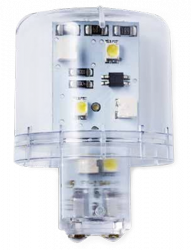
A short history of the LED
In 1961, Texas Instruments workers James R. Biard and Gary Pittman, discovered an LED, that emitted infrared light when electrical current was driven through it. A short time later, they filed a patent for their discovery. While their LEDs were being manufactured, Nick Holonyak worked on a way to build LEDs that emitted light on a visible spectrum. In 1962, Holonyak launched the first commercial LED and thereby started the industry’s further development on visible LED components.
Ongoing developments made the LED lamp a cost-effective, efficient and durable light source for many different applications. The semiconductor crystals used in the light-emitting diode achieve an ever-increasing light yield and the colour spectrum of LEDs has also been expanded.
A milestone was reached in 1996 with the development of the white LED by the Japanese company Nichia. With the help of colour converters, the light of a blue LED chip could be converted into white. The then head of research at Nichia, Shuji Nakamura demonstrated the first high-brightness blue LED. He was awarded the Nobel Prize in Physics in 2014 for an "invention for the greatest benefit of mankind".
LEDs from Auer Signal are available in different colours. Among the standard colors are: red, yellow, green, blue, clear, and orange. Series R multicolour lights additionally produce the colours turquoise and magenta.
Is there a difference between OLED and LED?
The technology for TV-screens has also been improved massively within the last few years. Many TVs are available with LED and also with OLED screens. The main difference lies in the picture quality. An LED TV needs backlight, to light the pixels up, with OLED they are self-illuminating, while also using less energy. This creates a deep black and sharp contrasts.
Here you can find more light bulb information:
The structure of a LED lamp
An LED lamp usually consists of 6 elements:
- LED chip
- Anode (+)
- cathode (-)
- Reflector through
- Potting
- Gold wire
Advantages of LED lamps
- high luminous efficacy: depending on the LED up to 200 lm/W, standard LEDs have an efficiency of up to 50 lm/W
- low power consumption
- long lifespan - up to 100,000 h
- Complete insensitivity to vibrations, shock, concussions, etc.
- completely maintenance-free
- small measurements
- instantaneous lighting
- no reduction in lifespan due to switching on/off
- low heat generation
- no "flickering" as with fluorescent tubes
- very little loss of luminosity due to the narrow spectrum of coloured domes
Disatvantages of LED lamps
- higher acquisition costs
- Small solid angle for the same luminous flux (also desired for some applications)
- Reduced lumen output over time
What is a Xenon light bulb?
A xenon light bulb is a gas (odorless and colourless) discharge lamp in which a glass tube is filled with the gas xenon and generates an intense flashing light at high pressure. It is equipped with a tungsten filament, which heats up until it glows and produces a bright white light, which closely mimics natural sunlight.
A xenon light bulb is used wherever brightest light signals are required. They’re used in areas such as surgical lighting or automotive, where they are used in automobile headlights. Their light reaches further than other lights which makes driving at nighttime safer. In the entertainment industry they are used in film projection.
No other type of lamp can generate such high luminous intensity in such a short time. The advantage of adding gas is that it prolongs the lifespan of the light bulb.
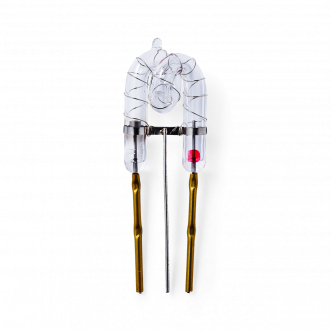
Structure of an Xenon light bulb
The xenon flash tube consists of a glass bulb made of quartz, which is filled with the noble gas xenon. In addition to the gas, the glass bulb is enriched with a small amount of mercury and metal halides. The metal halides are necessary for the colour tint of the light.
Two tungsten electrodes are fused inside the flash tube. The cathode is welded onto a thin tungsten pin, the anode is cylindrically shaped. To trigger the ignition, there is also an ignition electrode, which in some tubes is vapour-deposited or wound around the tube as a simple wire.
Advantages of Xenon light bulbs
- high signal effect through intensive light impulse
- Due to the fact, that Xenon light bulbs are not equipped with any toxic materials, their disposal is environmental-friendly
- excellent CRI
Disadvantages of Xenon light bulbs
- Flash tube will fog up black (blackering) inside over time - decreasing light output
- Limited lifespan due to high current density and the resulting strain on the electrodes or degeneration of the energy storage
- Reduced lifespan under vibration and shock
- Very low energy-efficiency: more than 90% of the energy is turned into heat, less than 10% creates visible light
What is an incandescent light bulb?
An incandescent light bulb is an electric light source in which a thin metal wire filament, usually made of tungsten, is heated until it glows. In order to avoid oxidation, the filament is enclosed in a bulb. Because of its shape, the incandescent lamp is also called a light bulb. Currently on the market, there are incandescent light bulbs with voltage ratings from 1.5 volts to about 300 volts.
For a long time, incandescent lamps were considered the standard light source for many applications. Many people are still familiar with the light bulb as a means of illumination for the living room. Due to their high energy consumption, the European Union and some other countries now ban all incandescent lamps that do not have at least energy efficiency class B. Excluded from this regulation are those special lamps whose primary purpose of light is not lighting. This includes luminaires for signaling purposes (EU Regulation 2015/1428).
The first incandescent lamps were developed in the middle of the 19th century. The invention of the screw base by Thomas Alva Edison was particularly decisive in this development. This thread, also known as the Edison thread, still resembles the sheet metal thread of a conventional light bulb today. A further milestone in the development of the light bulb was the use of tungsten wire instead of the previously used carbon filaments made of wood and plant fibres. Tungsten wire was many times more heat-resistant than the other threads.
A further development of the light bulb in the 1960s led to the development of halogen bulbs. By adding halogen inside the lamp, the glass bulb no longer discolours and the bulb wall remains clear. The luminous efficacy of halogen lamps is therefore greater than that of incandescent lamps.
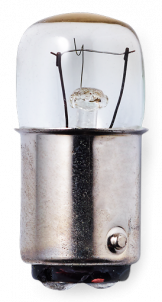
Structure of an incandescent lamp
A light bulb consists of three main parts:
- Base
- Glass bulb
- Filament
The base of a light bulb consists of a sheet metal thread. It is used to contact the bulb with electrical voltage.
The glass bulb not only protects the filament inside the bulb, but is also filled with inert gas (usually a mixture of argon and nitrogen). The gas mixture is necessary to prevent premature evaporation of the filament.
The filament, or the glow wire, is made of tungsten. Tungsten is a very heat-resistant material. It reaches its melting point at 3,422 °C and evaporates only very slowly at high temperatures.
Advantages of incandescent lamps
- simplest and most cost-effective light source
- Availability in various forms, voltages, power
- No external regulating equipment required
Disadvantages of incandescent lamps
- low luminous efficacy: 8-18 lm/W
- limited lifespan: approx. 1,000 h for standard lamps
- significantly reduced lifespan in case of vibrations, shock, flashing operation etc.
- blackening of the glass bulb with increasing lifespan
- "yellowish" light
- relatively high loss of light energy when penetrating coloured calottes
- high maintenance intensity due to regular lamp replacement
- Similar to the xenon light, it’s energy efficiency is very low.
What is a halogen lamp?
A halogen lamp basically uses the same technology as the incandescent lamp, which is why halogen lamps are also known as incandescent lamps. Just like incandescent lamps, halogen lamps create a continuous spectrum of light, which ranges from near ultraviolet to infrared. With halogen lamps, halogens (bromine, iodine) are added to the filling gas. These halogens allow a higher burning temperature of the tungsten wire, which improves the efficiency. In addition, the glass bulb is stronger than standard glass, because it is made of materials like fused quartz or aluminosilicate.
Halogen lamps differ from incandescent lamps in regard to the operating temperature of the filament, which is way higher and creates a light with a higher color temperature, with the best CRI possible, as well as a higher luminous efficacy and a longer lifespan. Halogen lamps must be distinguished from metal halide lamps. The light of a metal halide lamp is generated by a gas discharge and therefore does not use the same operating principle as a halogen lamp.
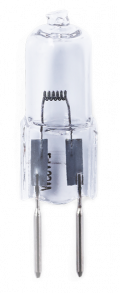
Structure of an halogen lamp
A halogen lamp, similar to an incandescent lamp, consists of the same three components: A base, glass bulb and the filament.
Unlike incandescent lamps, the base of halogen lamps is usually a pin base and not a threaded base. The small quartz bulb is filled with the gas bromine. Due to its small size, it heats up very quickly and thus favours the circulation of the gas with the tungsten bromide. Inside the quartz glass bulb is a tungsten filament, which combines with bromine to form tungsten bromide.
Depending on the electrical voltage, a transformer or an electronic ballast (EB) is required.
Advantages of halogen lamps
- higher luminous efficacy than incandescent lamp: up to 25 lm/W
- longer lifespan (about twice as long as incandescent lamps)
- low blackening of the glass bulb - uniform luminous flux over the entire life
- Higher and therefore better color temperature (2800-3400 Kelvin) compared to standard tungsten
- It does not require any time in order to heat up, so it delivers full brightness instantly
- it is dimmable
Disadvantages of halogen lamps
- limited lifespan: approx. 1500-3000 h
- reduced lifespan in case of vibrations, shock etc.
- Reduced lifespan in flashing operation (current peak during switching operation)
- relatively high loss of light energy when penetrating coloured calottes
- it heats up instantly, but also gets extremely hot, which can cause severe burns on the skin if the lamp is being touched





 ()
()


